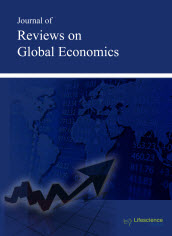jrge
Abstract - Socially Responsible Investment: A Comparison between the Performance of Sustainable and Traditional Stock Indexes
|
|
Abstract: The doubt about whether socially responsible investment is a viable strategy for investors seeking to maximize both social and financial returns is the central question of this paper. This is addressed by investigating whether portfolio selection based on sustainability criteria harms investor’s returns, or in contrast it can be a driver of superior financial benefits. With this purpose, daily prices and returns of 4 traditional and 10 sustainable stock indexes are analyzed from 2001 to 2011 and in the peaks and downs of both bull and bear markets. One of the major results of this study is that sustainable indexes outperform traditional stock indexes in all the periods under analysis; however the differences on average returns are not statistically significant. Through unit root tests we acknowledge that returns are stationary and levels are nonstationary. The short-run relationship analysis based on Granger causality test reveals a feedback effect between traditional and sustainable stock indexes returns. In contrast, long-run relationship, based on cointegration analysis, points that most of the stock indexes are not cointegrated, suggesting that sustainable and traditional stock indexes do not have a long-run linkage and thus can diverge without bound. Keywords: Socially responsible investment, Sustainable stock indexes, financial returns, Long run.Download Full Article |
Abstract - Analyzing the Synchronization between the Financial and Business Cycles in Turkey
|
|
Abstract: The primary purpose of this study was to investigate the relationships between the financial and business cycles in Turkey. A quarterly dataset was used for the analysis that covers the period from 1998Q1 to 2014Q4. The cycles were obtained with a Hodrick-Prescott (HP) filter design. The concordance index values, cross-correlation values and Dynamic Conditional Correlation (DCC) model were used to identify the characteristics of the relationships between the financial and business cycles. The empirical results revealed that the financial and business cycles are highly synchronized in Turkey. The results also indicate that while the credit volume cycle is the leading factor of the GDP cycle, the GDP cycle leads from the BIST 100 cycle in Turkey. The last significant conclusion is that the positive and high dynamic conditional correlations between the financial and business cycles experienced a break during the 2008 global crisis. Keywords: Business cycle, financial cycle, concordance index, DCC, Turkish economy.Download Full Article |
Abstract - Financial Development, Investment and Economic Growth: Evidence from Nigeria
|
|
Abstract: The paper evaluates the relationship among financial development, investment and economic growth in Nigeria. It also examines the role of investment in financial development and how it influences economic growth in Nigeria. The paper applies the standard Vector autoregression (VAR) framework of Johansen, the Inoue (1999) cointegration framework with endogenous structural break model and Johansen et al. (2000) cointegration test with exogenous structural breaks, respectively. After accounting for structural breaks in the series, the study establishes a long-run relationship among financial development, investment and economic growth. This indicates that failure to account for structural breaks in the series may lead to bias estimates and may mislead policy conclusion. It furtherreveals that investment is a critical channel that influences economic growth through financial development. Keywords: Financial development, Investment, Economic growth, Structural breaks. |
Abstract - Exchange Rate Flexibility and the Integration of the Securities Market in East Asia
|
|
Abstract: This paper discusses the time-varying degree of flexibility in exchange rate regimes and assesses the extent to which securities markets are integrated in East Asia. The dynamic conditional correlation model developed by Engle (2002) is used to analyze the time-varying characteristics of the conditional correlations of exchange rates as well as of bond and equity returns in emerging Asian economies. First, the presented analyses find that the flexibility of Asia’s exchange rate regimes increased substantially after the Asian crisis of 1997-98. Second, we show that Asia’s equity markets are becoming more globally and regionally integrated, whereas the bond markets in the region are still divided by national borders. These results suggest the existence of more scope for policymakers to promote financial integration in Asia, particularly in its bond markets. Keywords: Exchange rate flexibility, integration of the securities market, East Asia, dynamic conditional correlation.Download Full Article |
























